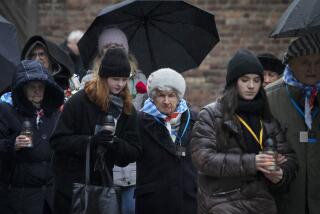Soviet Protests Urge Freedom for Baltic States
- Share via
VILNIUS, Soviet Union — More than 500 people, many repeatedly shouting “Freedom!,” demonstrated here Sunday for national independence on the anniversary of the infamous Hitler-Stalin pact that led to the absorption of Lithuania, Latvia and Estonia into the Soviet Union in 1940.
There were similar demonstrations Sunday in Riga, the capital of Latvia, and in the Estonian capital of Tallinn, all keyed to the Aug. 23, 1939, pact that was signed just eight days before Nazi leader Adolf Hitler launched World War II by invading Poland.
Although Soviet security officials kept a watchful eye on the demonstration here, there were no reports of attempts to break it up or to arrest participants.
‘Publish the Facts’
However, an Associated Press report from Moscow said police in Riga took away a man who held up a placard demanding, “Publish the facts about the Stalin cult.” Quoting a Latvian nationalist, Janus Roskalns, the AP said police smashed the video camera of a photographer believed to be a foreigner.
Several people at the open-air rally at the Lithuanian capital here said it would have been impossible to conduct such a meeting unmolested before Mikhail S. Gorbachev became Soviet leader in March, 1985, and launched his campaign for greater public openness.
Speakers denounced the Hitler-Stalin pact, and many in the crowd wore black mourning ribbons for victims of dictator Josef Stalin’s mass deportations following the Soviet takeover that turned the Baltic states into three of the Soviet Union’s 15 republics.
Critics of the Hitler-Stalin pact said it allowed the Nazi leader to start the war with assurance that the Soviet Union would not attack him from the East, while Moscow was able to annex Estonia, Latvia and Lithuania under a secret protocol.
The Soviet Union contends that it made the agreement with Hitler to buy time for war preparations and to help defend the three Baltic states. It insists that Lithuania, Latvia and Estonia voluntarily joined the Soviet Union in 1940, without referring to Soviet troops occupying the three nations.
Disputed for Centuries
For centuries the three states had been disputed territory among Poles, Germans and Russians. They had declared their independence after World War I following the collapse of Germany and the Russian Empire.
The annexations have never been formally recognized by the United States and other Western countries, and Washington still recognizes the exiled governments of the three Baltic states.
The emotional crowd here sang the former Lithuanian national anthem, in use before World War II, bringing tears to the eyes of several older participants.
The first speaker was Niyole Sadunaita, who had served six years in prison and in exile for publishing a Roman Catholic Church chronicle found to contain “anti-Soviet slander.” She demanded that the secret 1939 protocol be published in the Soviet Union and concluded a fiery speech with the words: “Freedom for Lithuania, Latvia, Estonia!”
A crowd around her burst into applause and chanted, “Freedom, Freedom, Freedom!”
Reports from Riga said several thousand people took part in the demonstration there that included the laying of a wreath at a memorial to war victims.
Several hundred people took part in a demonstration in Tallinn in what the Tass news agency described as a “propagandistic spectacle.”
Last week the Soviet media denounced the upcoming demonstrations as a provocation by Western overseas broadcasters and castigated them for what it said was their interference in Soviet domestic affairs.
In Vilnius, about 300 people crowded around a monument to 19th-Century Polish poet Adam Mickiewicz, who had close ties to Lithuania, and hundreds more watched and listened a short distance away. Western correspondents on the scene estimated that at least 500 people took part.
Tass, however, said only 30 “aggressive extremists” came to the monument, while 250 to 300 others were “casual passers-by.”
Arturas Baublys, an editor with Lithuanian television, said the crowd was a “strange mixture” of dissidents, religious persons, Russians and others.
‘They Have a Chance’
“They are speaking out because now they have a chance,” he concluded. “You can see that the police are not bothering anyone.” Members of the crowd, however, were aware that the demonstration was being filmed by a photographer in the second-floor window of a house across the street from the monument. Plainclothes police also infiltrated the crowd.
Julius Narvila, a young man from the nearby city of Kaunas, said the rally was a blend of religious and nationalist feelings.
“But when they sang the songs from before the war, they were weeping,” he added.
“Two years ago, the authorities would come with force and take you to jail (for demonstrating),” said Hubertus Patroucius, 34. “It was too dangerous. Now, it’s not so dangerous--we hope.”
More to Read
Sign up for Essential California
The most important California stories and recommendations in your inbox every morning.
You may occasionally receive promotional content from the Los Angeles Times.













